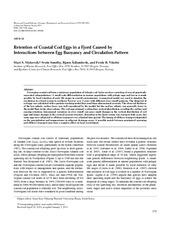| dc.contributor.author | Myksvoll, Mari Skuggedal | eng |
| dc.contributor.author | Sundby, Svein | eng |
| dc.contributor.author | Ådlandsvik, Bjørn | eng |
| dc.contributor.author | Vikebø, Frode B. | eng |
| dc.date.accessioned | 2012-04-18T10:40:48Z | |
| dc.date.available | 2012-04-18T10:40:48Z | |
| dc.date.issued | 2011-08-01 | eng |
| dc.Published | Marine and Coastal Fisheries 3(1): 279–294 | en |
| dc.identifier.issn | 1942-5120 | en_US |
| dc.identifier.other | https://www.tandfonline.com/doi/abs/10.1080/19425120.2011.595258 | |
| dc.identifier.uri | https://hdl.handle.net/1956/5755 | |
| dc.description.abstract | Norwegian coastal cod form a stationary population of Atlantic cod Gadus morhua consisting of several genetically separated subpopulations. A small-scale differentiation in marine populations with pelagic eggs and larvae is made possible by local retention of early life stages in coastal environments. A numerical model was used to simulate the circulation in a fjord system in northern Norway over 2 years with different river runoff patterns. The dispersal of cod eggs was calculated with a particle-tracking model that used three-dimensional currents. The observed thickness of the low-salinity surface layer was well reproduced by the model, but the surface salinity was generally lower in the model than in the observations. The cod eggs attained a subsurface vertical distribution, avoiding the surface and causing retention. Interannual variations in river runoff can cause small changes in the vertical distribution of cod eggs and larger changes in the vertical current structure. Retention in the fjord system was strong in both years, but some eggs were subjected to offshore transport over a limited time period. The timing of offshore transport depended on the precipitation and temperatures in adjacent drainage areas. A possible match between maximized spawning and offshore transport may have a negative effect on local recruitment. | en_US |
| dc.language.iso | eng | eng |
| dc.publisher | American Fisheries Society | en_US |
| dc.relation.ispartof | <a href="http://hdl.handle.net/1956/5756" target="blank">Connectivity among subpopulations of Norwegian Coastal cod. Impacts of physical-biological factors during egg stages.</a> | en_US |
| dc.title | Retention of Coastal Cod Eggs in a Fjord Caused by Interactions between Egg Buoyancy and Circulation Pattern | en_US |
| dc.type | Peer reviewed | |
| dc.type | Journal article | |
| dc.description.version | publishedVersion | en_US |
| dc.rights.holder | Copyright American Fisheries Society 2011 | en_US |
| dc.subject.nsi | VDP::Mathematics and natural science: 400::Zoology and botany: 480::Marine biology: 497 | en_US |
| dc.subject.nsi | VDP::Agriculture and fishery disciplines: 900::Fisheries science: 920 | en_US |
